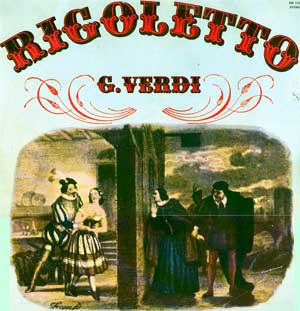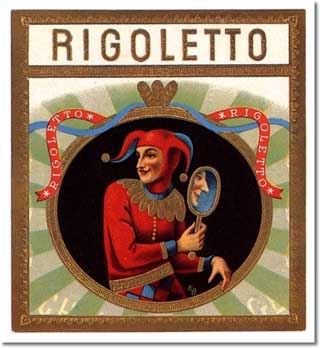Opera (1851)
by Giuseppi Verdi
Boston Lyric Opera
Citi Performing Arts Center / Shubert Theatre
Boston, MA
March 14 – 23, 2014
Conductor: Christopher Franklin
Set Designer: John Conklin; Costume Designer: Victoria Tzykun;
With Bruce Sledge (The Duke of Mantua), Omar Najmi (Borsa), Chelsea Basler (Countess Ceprano), Michael Mayes (Rigoletto), David Kravitz (Marullo), Liam Moran (Count Ceprano, Count Monterone), Morris Robinson (Sparafucile), Nadine Sierra (Gilda), Samantha Weppelmann (Giovanna), Vanessa Schukis (The Duchess of Mantua), Ron Williams (Usher), Audrey Babcock (Maddalena)
Rigoletto sounds like it should be the name of a squiggly pasta, but it is actually the name of the hunchbacked court jester for the Duke of Mantua. His job is to humor the Duke, which involves going along, in some fashion, with a lot of the Duke’s relentless seductive manipulation of female lovers. The father of one of the girls, Count Monterone, calls the Duke and Rigoletto out onto the carpet and winds up delivering a curse upon them. The Duke, being a true sociopath, doesn’t make too much of it, but the curse unsettles Rigoletto. To make matters worse and the opera plot complete, the Duke, on the side, has taken up with Rigoletto’s beautiful daughter Gilda, and when Rigoletto finds out about it he is none too pleased. An assassin, Sparafucile, is brought into play and the wheels of damnation begin to turn.
The plot of the opera, taken from Victor Hugo’s 1832 play Le Roi S’amuse (The King Amuses Himself), is a bit unsettling in its moral implications. Usually classical and romantic grand opera involves a sense of deserved retribution, and the villains usually go down in style. Certainly, in the closest Mozartian antecedent to Rigoletto, Don Giovanni, the eponymous protagonist and villain of the opera dissolves in flames for his sociopathic manipulations of women. Just a few years before, Verdi had written Macbeth (1847) which does involve retribution, though for non-romantic violations, and it is curious that Rigoletto provides punishment only for the poor underling while seeming to let the major transgressor off the hook.
The is the opera that features the very famous La donna è mobile (Woman is fickle) aria, sung by the errant Duke time and again. Though he is a creep and the message is creepy, the aria, fortunately, is lovely. And though lovely, it is also a kind of clarion call about the kind of unbridled manipulation that runs rampant and goes unchecked, frequently in the world at large, and certainly within the confines of this opera.
The Boston Lyric Opera does not offer opera on the scale of the Metropolitan Opera, but it does a darn good job in producing more modestly designed and scaled productions. The sets are quite simple, generally, but usually quite effective. And though the voices tend not to be quite as large as those which fill out the Met house, they are almost always first-rate.
This production is no exception. The three principals, Michael Mayes (Rigoletto), Nadine Sierra (Gilda) and Bruce Sledge (The Duke of Mantua) are all distinctively good. The clarity and strength of Sledge’s voice was the first thing that struck me, its consistency notable. At first I was a bit unsure of Sierra’s soprano, which, at the outset, though clear, seemed a bit pinched. But she really grew on me, and especially when she gave her famous aria lying on the stage, almost whispering it with mellifluous sonority, I was really taken. And Mayes’ Rigoletto was robust and charming; he beautifully embodied the role both in vocal and dramatic senses. Morris Robinson, who played the assassin, Sparafucile, has a basso which is so profundo and rich it is quite striking. The role is not huge, but his voice is and it made for several stirring, reverberating moments.
The orchestra was in fine form. Again, it is not the Met orchestra, but, for that matter, nothing is. The BLO orchestra plays together a few times year and the Met orchestra goes at it practically every day. So, given that they are somewhat more of an ad hoc group, they do an extremely decent job. And the new conductor, Christopher Franklin, kept things moving right along.
The sets by John Conklin, based on a painting by Piero della Francesca, were effective and to the point, and the costumes were appropriately colorful and ornate. It was an effective set of embellishments for this stirring but ambiguous moral tale told in tuneful, singable, wonderfully memorable arias.
Again, this production represents a noble and effective point scored by Boston’s very own.
– BADMan



Leave a Reply